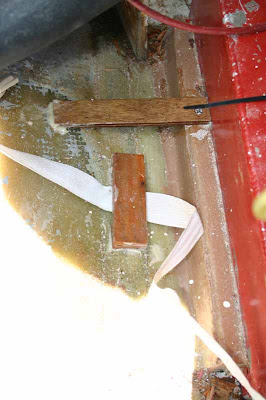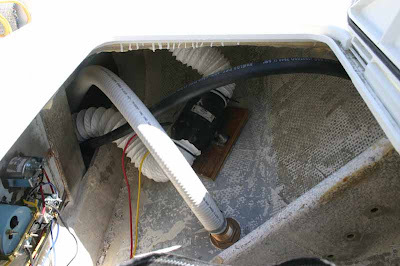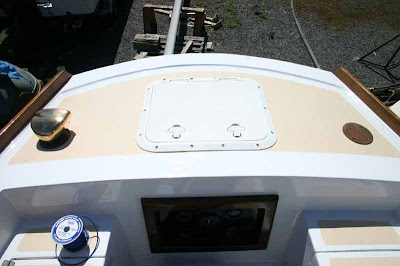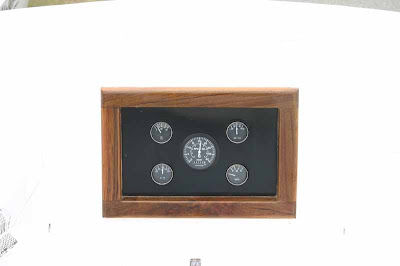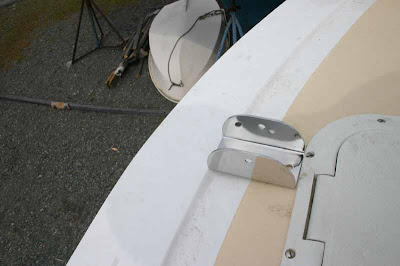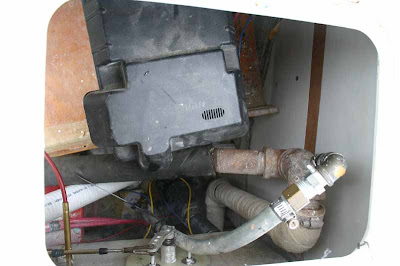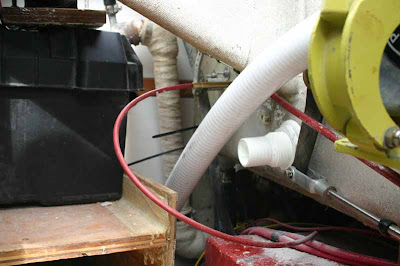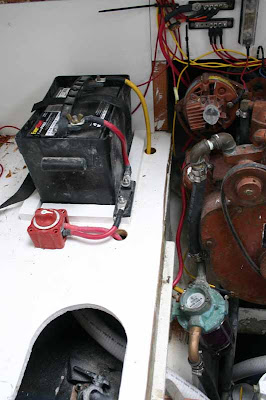I finished the cooling system check by refilling the exchanger with an antifreeze solution.
Then I removed the spark plugs and squirted some WD40 into the cylinders and then turned the engine over by hand a few times. Then I hit the starter button and motored the engine for about 30 seconds to get the oil flowing. While motoring, I stuck my thumb over each of the spark plug holes to make sure I was getting good compression. 'Good' on an Atomic Four means it pushes my thumb out of the way. These engines have very low compression ratios.
Then I started on the fuel. The fuel tank is brand new so I poured in a gallon and checked things out. I spent several minutes looking around for leaks and such. It all looked good. The manual quantity gauge jumped right up so I made a mark at the 1 gallon point for future reference. Then I was curious as to how much of the fuel was unavailable, i.e. below the suction tube, so I put a jumper wire on the oil pressure safety switch...

... pulled the fuel hose off the carburetor and into a plastic jug ...

... turned on the ignition and found the fuel pump had no problem pulling this fuel and delivering it to the carburetor. The pump I got from Moyer Marine actually puts out WAY more fuel than the engine needs. No worries there.
Then I poured the rest of my five gallon jug of gasoline into the tank and again checked for leaks.

I also made a mark at the 5 gallon indication. The 'V' shaped tank slopes forward toward the indicator so the fuel indication rises rapidly until the wider sections of the tank start taking fuel.
Then I filled a bucket of water and put my alternate water supply hose in place and was ready to start the engine.

Sadly, nothing happened. The motor cranked but it did not come to life.
So then I started in on the troubleshooting. I removed the front spark plug and holding it against the block I cranked the engine again. There was no spark jumping across the gap in the spark plug. There was a fine mist of fuel in the cylinder though.
Then I pulled the wire going from the coil to the distributor and cranked again. No spark coming out of the coil.
Then I took the positive wires off the coil and using another jumper, momentarily applied voltage to the coil. Then I got spark.
So then I started thinking the coil was not getting the signal from the electronic ignition to fire. Per the manufacturer's instructions I ran a jumper wire from the battery directly to the coil to check for a low voltage indication. No change.
Then I pulled the distributor apart and checked the electronic ignition. There really isn't much to see and it looked fine.
Then I did it all again...
I suspect the electronic ignition since everything else seems to be working. I don't know yet if there is a way to check the electronic igntion without simply replacing it. If the wires get crossed, it can fry the unit. If power is left on for too long it can fry the unit. None of these things happened to my knowledge but it is a possibility.
So that was a big bummer. It might even be the killing blow to my launch plans. I really don't have time in my schedule for an engine that doesn't work. It worked the last time the boat was operated. I have some inquiries out there. Hopefully, I can get it resolved quickly.
Then I turned to the rigging. I needed the chainplates put back in.
A few years ago, to stop the constant leaking from the boat being outdoors (next time indoor storage!) I had filled the chainplate slots during the deck reconstruction.

I left it so that with a long drill I could drill through the holes from the botton to re-locat the slots on deck.

Using my Rotozip tool I connected the locating holes.

And then, ever so carefully, going a little bit at a time, up on deck and then down below to test it out, I cut out the holes to the proper dimensions.
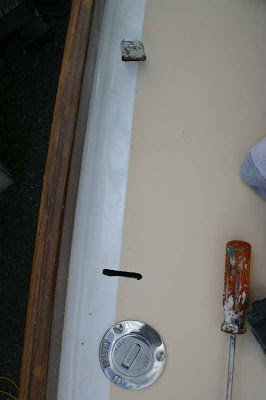
I opened up the slots a bit too wide one one spot. That's okay since the stern slot had never been 'drilled and filled' to create a moisture barrier between the deck core and the hole. The other slots had been cut out, filled with thickened epoxy and then recut to the proper size during the first year that I worked on the boat.

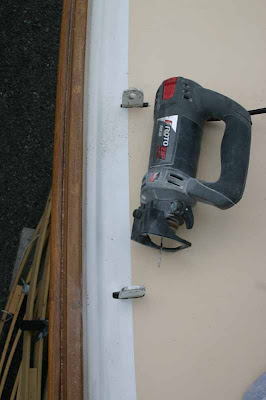
I was just about to mix up some thickened epoxy when...

We got hit with a torrential downpour. I went below and checked for leaks there were none except for the fresh holes in the deck. I hung out down below for half an hour cleaning up and going through my random hardware bins until it became clear that my day was done.
It was good to get started on the chainplates. It feels right to be working towards making the boat sail again. The engine is a real bummer. I am launching and will be moored in a river with 3+ knots of current at times. A sail only boat is not an option here unless I have the leisure time to wait out the tidal currents (which I don't)
Highs and lows. Whether I actually win and get the boat launched on time is still in question. I guess that is what makes it all so interesting.




